
(a)
The IS and the LM equilibrium of the economy.
(a)
Explanation of Solution
The investment function of the economy is given by
The values of the C, T, I and G can be plugged into the IS equation as follows:
The money
The supply of real money balances can be calculated by dividing the money supply with the price level in the economy. Since the values of the two are given, the value of the supply of the real money balances can be calculated as follows:
Thus, the supply of real money balance is 3,000. The LM curve can be calculated by setting the demand equation equal to the supply equation as follows:
The IS - LM equilibrium can be calculated by equating the IS equation equal to the LM equation. Thus, the IS-LM equilibrium can be calculated as follows:
By substituting the value of r in any equation, it can provide the value of Y as follows:
Thus, the rate of interest and the Y is 10 and 5,000, respectively. These values can be illustrated at point A through the graph as follows:
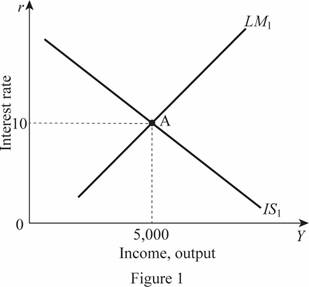
In Figure 1, horizontal axis measures the income or output and vertical axis measures the interest rate.
Fiscal policy: The fiscal policy is the policy of the government regarding the government expenditures and taxes of the economy.
(b)
The impact of tax cuts of 20 percent on the IS-LM equilibrium and the tax multiplier.
(b)
Explanation of Solution
When the tax rate decreases by 20 percent, the tax will be 800 in the economy. The IS curve will be then as follows:
The IS - LM equilibrium can be calculated by equating the IS equation equal to the LM equation. Thus, the IS-LM equilibrium can be calculated as follows:
By substituting the value of r in any equation, it can provide the value of Y as follows:
Thus, the rate of interest and the Y is 11.5 and 5,300, respectively. These values can be illustrated through the graph as follows:
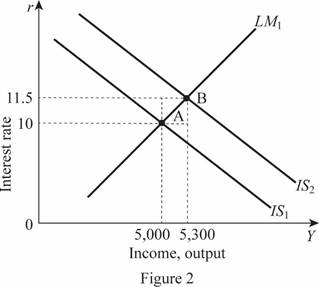
In Figure 2, horizontal axis measures the income or output and vertical axis measures the interest rate. Thus, the decrease in the tax rate by 20 percent leads to a shift in the IS curve toward the right by 300 forming a new equilibrium point B. The tax multiplier can be calculated by subtracting the change in the total output by the negative change in the taxes as follows:
Thus, the tax multiplier is -1.5.
(c)
The impact of holding the interest rate constant by Fed on Equilibrium.
(c)
Explanation of Solution
The supply of real money balances can be calculated by dividing the money supply with the price level in the economy. Since the values of the two are given, the value of the supply of the real money balances can be calculated as follows:
The LM curve can be calculated by setting the demand equation equal to the supply equation as follows:
The IS - LM equilibrium can be calculated by equating the IS equation equal to the LM equation. Thus, the rate of interest is held constant which is equal to 10 and this value can be substituted in the equilibrium equation in order to calculate the money supply as follows:
By substituting the value of r in any equation, it can provide the value of Y as follows:
Thus, the rate of interest is held constant by the fed and adjusted the money supply to 7,600. Then, the Y is calculated as 5,600. These values can be illustrated through the graph as follows:
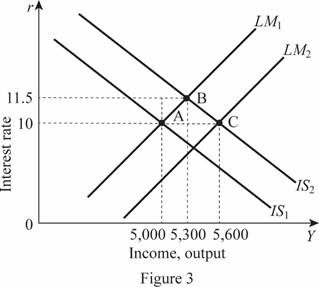
In Figure 3, horizontal axis measures the income or output and vertical axis measures the interest rate. Thus, the change leads to a shift in the LM curve toward the right by 600 by forming a new equilibrium point C. The tax multiplier can be calculated by subtracting the change in the total output by the negative change in the taxes as follows:
Thus, the tax multiplier is -3.
(d)
The impact keeping income constant through money supply on equilibrium and the tax multiplier.
(d)
Explanation of Solution
When the Fed gives importance to keep the income of the economy constant at 5,000 after the tax deduction, the value of the rate of interest can be calculated by plugging the value of the Y into the equation as follows:
Thus, the rate of interest in the economy will be then 13, which can be substituted in the LM curve to calculate the value of M as follows:
Thus, the value of M is 4,800. Thus, M decreases to 4,800 from 7,600 which means the LM curve will shift toward the left reducing the equilibrium to point D. Therefore, it can be illustrated as follows:
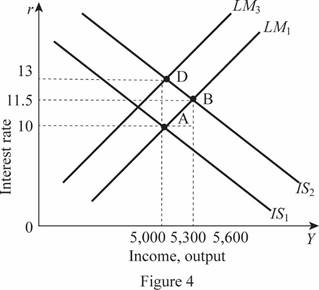
In Figure 4, horizontal axis measures the income or output and vertical axis measures the interest rate. Since the output is not changing and maintaining the same level of 5,000, there will be zero tax multiplier in the economy.
(d)
The illustration of all the equilibrium points of all the changes.
(d)
Explanation of Solution
The various IS-LM equilibrium points can be illustrated on the single graph as A, B, C, and D as follows:
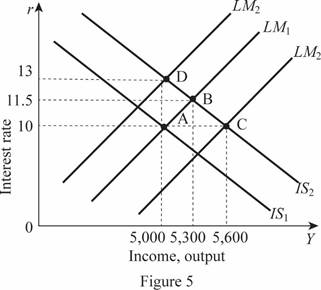
In Figure 5, horizontal axis measures the income or output and vertical axis measures the interest rate.
Want to see more full solutions like this?
- 2. What is the payoff from a long futures position where you are obligated to buy at the contract price? What is the payoff from a short futures position where you are obligated to sell at the contract price?? Draw the payoff diagram for each position. Payoff from Futures Contract F=$50.85 S1 Long $100 $95 $90 $85 $80 $75 $70 $65 $60 $55 $50.85 $50 $45 $40 $35 $30 $25 Shortarrow_forward3. Consider a call on the same underlier (Cisco). The strike is $50.85, which is the forward price. The owner of the call has the choice or option to buy at the strike. They get to see the market price S1 before they decide. We assume they are rational. What is the payoff from owning (also known as being long) the call? What is the payoff from selling (also known as being short) the call? Payoff from Call with Strike of k=$50.85 S1 Long $100 $95 $90 $85 $80 $75 $70 $65 $60 $55 $50.85 $50 $45 $40 $35 $30 $25 Shortarrow_forward4. Consider a put on the same underlier (Cisco). The strike is $50.85, which is the forward price. The owner of the call has the choice or option to buy at the strike. They get to see the market price S1 before they decide. We assume they are rational. What is the payoff from owning (also known as being long) the put? What is the payoff from selling (also known as being short) the put? Payoff from Put with Strike of k=$50.85 S1 Long $100 $95 $90 $85 $80 $75 $70 $65 $60 $55 $50.85 $50 $45 $40 $35 $30 $25 Shortarrow_forward
- The following table provides information on two technology companies, IBM and Cisco. Use the data to answer the following questions. Company IBM Cisco Systems Stock Price Dividend (trailing 12 months) $150.00 $50.00 $7.00 Dividend (next 12 months) $7.35 Dividend Growth 5.0% $2.00 $2.15 7.5% 1. You buy a futures contract instead of purchasing Cisco stock at $50. What is the one-year futures price, assuming the risk-free interest rate is 6%? Remember to adjust the futures price for the dividend of $2.15.arrow_forward5. Consider a one-year European-style call option on Cisco stock. The strike is $50.85, which is the forward price. The risk-free interest rate is 6%. Assume the stock price either doubles or halves each period. The price movement corresponds to u = 2 and d = ½ = 1/u. S1 = $100 Call payoff= SO = $50 S1 = $25 Call payoff= What is the call payoff for $1 = $100? What is the call payoff for S1 = $25?arrow_forwardMC The diagram shows a pharmaceutical firm's demand curve and marginal cost curve for a new heart medication for which the firm holds a 20-year patent on its production. Assume this pharmaceutical firm charges a single price for its drug. At its profit-maximizing level of output, it will generate a total profit represented by OA. areas J+K. B. areas F+I+H+G+J+K OC. areas E+F+I+H+G. D. - it is not possible to determine with the informatio OE. the sum of areas A through K. (...) Po P1 Price F P2 E H 0 G B Q MR D ōarrow_forward
- Price Quantity $26 0 The marketing department of $24 20,000 Johnny Rockabilly's record company $22 40,000 has determined that the demand for his $20 60,000 latest CD is given in the table at right. $18 80,000 $16 100,000 $14 120,000 The record company's costs consist of a $240,000 fixed cost of recording the CD, an $8 per CD variable cost of producing and distributing the CD, plus the cost of paying Johnny for his creative talent. The company is considering two plans for paying Johnny. Plan 1: Johnny receives a zero fixed recording fee and a $4 per CD royalty for each CD that is sold. Plan 2: Johnny receives a $400,000 fixed recording fee and zero royalty per CD sold. Under either plan, the record company will choose the price of Johnny's CD so as to maximize its (the record company's) profit. The record company's profit is the revenues minus costs, where the costs include the costs of production, distribution, and the payment made to Johnny. Johnny's payment will be be under plan 2 as…arrow_forwardWhich of the following is the best example of perfect price discrimination? A. Universities give entry scholarships to poorer students. B. Students pay lower prices at the local theatre. ○ C. A hotel charges for its rooms according to the number of days left before the check-in date. ○ D. People who collect the mail coupons get discounts at the local food store. ○ E. An airline offers a discount to students.arrow_forwardConsider the figure at the right. The profit of the single-price monopolist OA. is shown by area D+H+I+F+A. B. is shown by area A+I+F. OC. is shown by area D + H. ○ D. is zero. ○ E. cannot be calculated or shown with just the information given in the graph. (C) Price ($) B C D H FIG шо E MC ATC A MR D = AR Quantityarrow_forward
- Consider the figure. A perfectly price-discriminating monopolist will produce ○ A. 162 units and charge a price equal to $69. ○ B. 356 units and charge a price equal to $52 for the last unit sold only. OC. 162 units and charge a price equal to $52. OD. 356 units and charge a price equal to the perfectly competitive price. Dollars per Unit $69 $52 MR 162 356 Output MC Darrow_forwardThe figure at right shows the demand line, marginal revenue line, and cost curves for a single-price monopolist. Now suppose the monopolist is able to charge a different price on each different unit sold. The profit-maximizing quantity for the monopolist is (Round your response to the nearest whole number.) The price charged for the last unit sold by this monopolist is $ (Round your response to the nearest dollar.) Price ($) 250 225- 200- The monopolist's profit is $ the nearest dollar.) (Round your response to MC 175- 150 ATC 125- 100- 75- 50- 25- 0- °- 0 20 40 60 MR 80 100 120 140 160 180 200 Quantityarrow_forwardThe diagram shows a pharmaceutical firm's demand curve and marginal cost curve for a new heart medication for which the firm holds a 20-year patent on its production. At its profit-maximizing level of output, it will generate a deadweight loss to society represented by what? A. There is no deadweight loss generated. B. Area H+I+J+K OC. Area H+I D. Area D + E ◇ E. It is not possible to determine with the information provided. (...) 0 Price 0 m H B GI A MR MC D Outparrow_forward

 Microeconomics: Private and Public Choice (MindTa...EconomicsISBN:9781305506893Author:James D. Gwartney, Richard L. Stroup, Russell S. Sobel, David A. MacphersonPublisher:Cengage Learning
Microeconomics: Private and Public Choice (MindTa...EconomicsISBN:9781305506893Author:James D. Gwartney, Richard L. Stroup, Russell S. Sobel, David A. MacphersonPublisher:Cengage Learning Macroeconomics: Private and Public Choice (MindTa...EconomicsISBN:9781305506756Author:James D. Gwartney, Richard L. Stroup, Russell S. Sobel, David A. MacphersonPublisher:Cengage Learning
Macroeconomics: Private and Public Choice (MindTa...EconomicsISBN:9781305506756Author:James D. Gwartney, Richard L. Stroup, Russell S. Sobel, David A. MacphersonPublisher:Cengage Learning Economics: Private and Public Choice (MindTap Cou...EconomicsISBN:9781305506725Author:James D. Gwartney, Richard L. Stroup, Russell S. Sobel, David A. MacphersonPublisher:Cengage Learning
Economics: Private and Public Choice (MindTap Cou...EconomicsISBN:9781305506725Author:James D. Gwartney, Richard L. Stroup, Russell S. Sobel, David A. MacphersonPublisher:Cengage Learning






